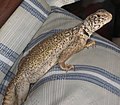This article needs additional citations for verification .(July 2023) |
| Uromastyx [1] | |
|---|---|
 | |
| Egyptian spiny-tailed lizard ( Uromastyx aegyptia ) | |
| Scientific classification | |
| Kingdom: | Animalia |
| Phylum: | Chordata |
| Class: | Reptilia |
| Order: | Squamata |
| Suborder: | Iguania |
| Family: | Agamidae |
| Subfamily: | Uromasticinae |
| Genus: | Uromastyx Merrem, 1820 |
| Species | |
See text | |
| Synonyms | |
Jeddaherdan | |
Uromastyx is a genus of lizards in the family Agamidae. The genus is native to Africa and the Middle East (West Asia). Members of the species are commonly called spiny-tailed lizards, uromastyces, mastigures, or dabb lizards.
Contents
- Taxonomy
- Species
- Description
- Distribution
- Diet
- Reproduction
- Relationship with humans
- Captivity
- Consumption by humans
- See also
- References
- External links
Lizards in the genus Uromastyx are primarily herbivorous, but occasionally eat insects and other small animals, especially young lizards. They spend most of their waking hours basking in the sun, hiding in underground chambers at nighttime or when danger appears. They tend to establish themselves in hilly, rocky areas with good shelter and accessible vegetation.










